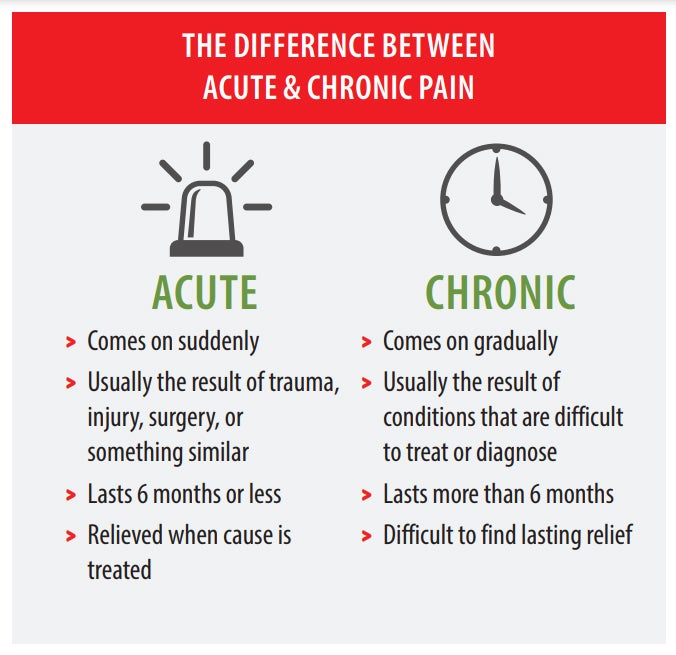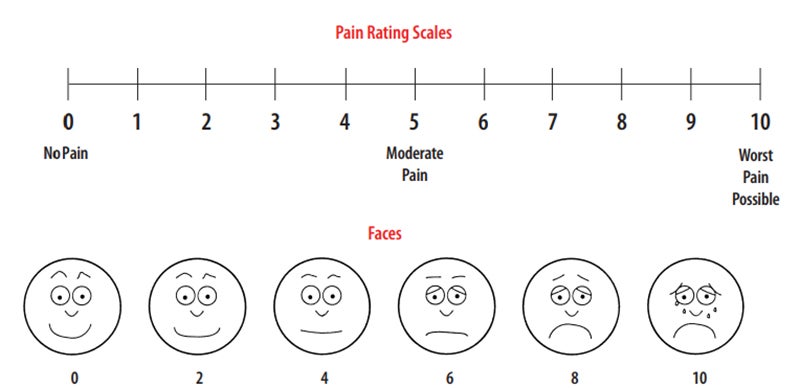Trauma & Chronic Pain
What is chronic pain?
Chronic pain is different from acute pain because it persists long after the initial injury occurred and the body has healed. Changes can happen in brain chemistry and neural wiring in response to an injury that causes the nerves to fire inappropriately and excessively. This is interpreted in the brain as pain.

Who gets chronic pain?
- Two in 3 patients who experience a traumatic injury have chronic pain for at least 1 year after the injury. Trauma survivors who are women or who had untreated depression before injury are more likely to suffer from chronic pain.
- People who have experienced childhood trauma or suffer from PTSD are 10 times more likely to experience chronic pain due to the mind-body connection. In other words, mental and emotional pain can manifest as physical pain.
How do my providers measure pain?
Typically, your nurse or provider will ask you to rate your pain on a scale of 1-10.
If you have pain before you arrived in the hospital (before your injury) and if you take pain medication regularly at home, this may affect how we can treat your pain in the hospital.
How is chronic pain managed?
Chronic pain is frequently less affected by the same medicines that treat acute pain (Advil, Tylenol, opioids, etc.). These medications may play a role, but treatment of chronic pain requires a more holistic approach.
This is because chronic pain does not come from the same place as acute pain does and there may be a large psychological component to it. Good mental health and regular exercise have shown to decrease chronic pain in trauma survivors.
Treatment usually has many parts to it: counseling for psychological coping (see the graphic below), physical therapy, regular primary care physician visits and occasionally a pain management specialist.
How perspective can alter chronic pain
KNOWLEDGE
The brain processes chronic pain using its fear system. In order to reverse the cycle of pain, the rational part of the brain (the prefrontal cortex) often needs to get more involved. Simply learning about how pain works can help the prefrontal cortex play a larger role.
SELF DISCOVERY
To help the nervous system feel safe again, it is critical to understand what made it feel unsafe. This can be completed through guided writing exercises or with the help of a professional. An understanding of the nervous system’s journey into pain will provide a clearer map of the way out.
TARGETED REWIRING
The process of rewiring the neural pathways of chronic pain requires experimentation, patience and consistency. Science-backed techniques, like those found in the Curable app, can greatly assist in this process.
Common techniques include:
- Pain Science Education
- Guided Meditation
- Guided Visualization
- Graded Motor Imagery
- Cognitive Behavioral Therapy
- Expressive Writing
- Brain-Centric PT
- Social/Peer Support
- And many more
NEW NEURAL PATHWAYS
Armed with a new perspective on pain, it is possible to start teaching an old nervous system new tricks. Joy, play, gratitude and physical activity are powerful habits that release natural pain-relieving chemicals. The more these new habits are practiced, the more comfortable they will feel in the nervous system.
A FRESH PERSPECTIVE
Following these steps can greatly reduce physical symptoms, but that is not the only benefit. The work it takes to unlearn chronic pain impacts every aspect of life, allowing for a deeper understanding of the self, better relationships, a great enjoyment of everyday life and a loving relationship with the body.

Some resources for you to explore:
- Wake County Network of Care
- Substance Abuse and Mental Health Services Administration Resources 1-800-662-HELP (4357)
- National Alliance on Mental Illness of North Carolina 1-800-950-NAMI (6264) or in a crisis, text “NAMI” to 741741
- Wake Spine & Pain 919-373-5122
- If you or someone you know is in crisis, Call the National Suicide Prevention Lifeline (Lifeline) at 1-800-273-TALK (8255) or text the Crisis Text Line (text HELLO to 741741).
Images adapted from www.curablehealth.com, University of Virginia. Information adapted from Rivara FP, MacKenzie EJ, Jurkovich GJ, Nathens AB, Wang J, Scharfstein DO. Prevalence of Pain in Patients 1 Year After Major Trauma. Arch Surg. 2008;143(3):282–287 and the Oregon Pain Guidance Group.